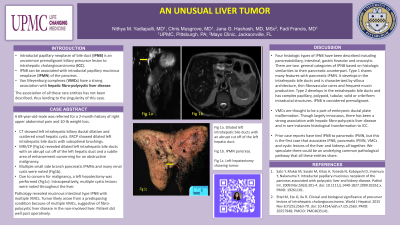Back


Poster Session A - Sunday Afternoon
Category: Biliary/Pancreas
A0062 - An Unusual Liver Tumor
Sunday, October 23, 2022
5:00 PM – 7:00 PM ET
Location: Crown Ballroom

Has Audio

Nithya M. Yadlapalli, MD
UPMC
Cranberry Township, PA
Presenting Author(s)
Nithya M. Yadlapalli, MD1, Chris Musgrove, MD2, Jana G. Hashash, MD, MSc3, Fadi Francis, MD2
1UPMC, Cranberry Township, PA; 2UPMC, Pittsburgh, PA; 3Mayo Clinic Florida, Jacksonville, FL
Introduction: Intraductal papillary neoplasm of bile duct (IPNB) is an uncommon premalignant biliary precursor lesion to intrahepatic cholangiocarcinoma (ICC). IPNB can be associated with intraductal papillary mucinous neoplasm (IPMN) of the pancreas. Von Meyenburg complexes (VMCs) have a strong association with hepatic fibro-polycystic liver disease. The association of all these rare entities has not been described, thus lending to the singularity of this case.
Case Description/Methods: A 69-year-old-male was referred for a 2-month history of right upper abdominal pain and 10-lb weight loss. CT showed left intrahepatic biliary ductal dilation and scattered small hepatic cysts. ERCP showed dilated left intrahepatic bile ducts with suboptimal brushings. MRI/CP (Fig1a) revealed dilated left intrahepatic bile ducts with an abrupt cut off of the left hepatic duct and a subtle area of enhancement concerning for an obstructive malignancy. Multiple small side branch pancreatic IPMNs and many renal cysts were noted (Fig1b). Due to concern for malignancy, a left hepatectomy was performed (Fig1c). Intraoperatively, multiple cystic lesions were noted throughout the liver. Pathology revealed mucinous intestinal type IPNB with multiple VMCs. Tumor likely arose from a predisposing condition because of multiple VMCs, suggestive of fibro-polycystic liver disease in the non-involved liver. Patient did well post operatively.
Discussion: Four histologic types of IPNB have been described including pancreatobiliary, intestinal, gastric foveolar and oncocytic. There are 2 general categories of IPNB based on histologic similarities to their pancreatic counterpart. Type 1 shares many features with pancreatic IPMN. It develops in the intrahepatic bile ducts and is characterized by villous architecture, thin fibrovascular cores and frequent mucin production. Type 2 develops in the extrahepatic bile ducts and has complex papillary, polypoid, tubular, solid or cribriform intraductal structures. IPNB is considered premalignant.
VMCs are thought to be a part of embryonic ductal plate malformation. Though largely innocuous, there has been a strong association with hepatic fibro-polycystic liver disease and in rare instances histological transformation to ICC.
Prior case reports have tied IPNB to pancreatic IPMN, but this is the first case that associates IPNB, pancreatic IPMN, VMCs and cystic lesions of the liver and kidneys all together. We speculate there could be an underlying common pathological pathway that all these entities share.

Disclosures:
Nithya M. Yadlapalli, MD1, Chris Musgrove, MD2, Jana G. Hashash, MD, MSc3, Fadi Francis, MD2. A0062 - An Unusual Liver Tumor, ACG 2022 Annual Scientific Meeting Abstracts. Charlotte, NC: American College of Gastroenterology.
1UPMC, Cranberry Township, PA; 2UPMC, Pittsburgh, PA; 3Mayo Clinic Florida, Jacksonville, FL
Introduction: Intraductal papillary neoplasm of bile duct (IPNB) is an uncommon premalignant biliary precursor lesion to intrahepatic cholangiocarcinoma (ICC). IPNB can be associated with intraductal papillary mucinous neoplasm (IPMN) of the pancreas. Von Meyenburg complexes (VMCs) have a strong association with hepatic fibro-polycystic liver disease. The association of all these rare entities has not been described, thus lending to the singularity of this case.
Case Description/Methods: A 69-year-old-male was referred for a 2-month history of right upper abdominal pain and 10-lb weight loss. CT showed left intrahepatic biliary ductal dilation and scattered small hepatic cysts. ERCP showed dilated left intrahepatic bile ducts with suboptimal brushings. MRI/CP (Fig1a) revealed dilated left intrahepatic bile ducts with an abrupt cut off of the left hepatic duct and a subtle area of enhancement concerning for an obstructive malignancy. Multiple small side branch pancreatic IPMNs and many renal cysts were noted (Fig1b). Due to concern for malignancy, a left hepatectomy was performed (Fig1c). Intraoperatively, multiple cystic lesions were noted throughout the liver. Pathology revealed mucinous intestinal type IPNB with multiple VMCs. Tumor likely arose from a predisposing condition because of multiple VMCs, suggestive of fibro-polycystic liver disease in the non-involved liver. Patient did well post operatively.
Discussion: Four histologic types of IPNB have been described including pancreatobiliary, intestinal, gastric foveolar and oncocytic. There are 2 general categories of IPNB based on histologic similarities to their pancreatic counterpart. Type 1 shares many features with pancreatic IPMN. It develops in the intrahepatic bile ducts and is characterized by villous architecture, thin fibrovascular cores and frequent mucin production. Type 2 develops in the extrahepatic bile ducts and has complex papillary, polypoid, tubular, solid or cribriform intraductal structures. IPNB is considered premalignant.
VMCs are thought to be a part of embryonic ductal plate malformation. Though largely innocuous, there has been a strong association with hepatic fibro-polycystic liver disease and in rare instances histological transformation to ICC.
Prior case reports have tied IPNB to pancreatic IPMN, but this is the first case that associates IPNB, pancreatic IPMN, VMCs and cystic lesions of the liver and kidneys all together. We speculate there could be an underlying common pathological pathway that all these entities share.

Figure: 1a. Dilated left intrahepatic bile ducts with an abrupt cut off of the left hepatic duct.
1b. IPMN pancreas.
1c. Left hepatectomy showing tumor.
1b. IPMN pancreas.
1c. Left hepatectomy showing tumor.
Disclosures:
Nithya Yadlapalli indicated no relevant financial relationships.
Chris Musgrove indicated no relevant financial relationships.
Jana Hashash indicated no relevant financial relationships.
Fadi Francis indicated no relevant financial relationships.
Nithya M. Yadlapalli, MD1, Chris Musgrove, MD2, Jana G. Hashash, MD, MSc3, Fadi Francis, MD2. A0062 - An Unusual Liver Tumor, ACG 2022 Annual Scientific Meeting Abstracts. Charlotte, NC: American College of Gastroenterology.
